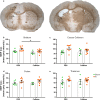Defining a Time Window for Neuroprotection and Glia Modulation by Caffeine After Neonatal Hypoxia-Ischaemia
- PMID: 31974940
- PMCID: PMC7170835
- DOI: 10.1007/s12035-020-01867-9
Defining a Time Window for Neuroprotection and Glia Modulation by Caffeine After Neonatal Hypoxia-Ischaemia
Abstract
Hypoxic-ischemic (HI) brain injury remains an important cause of brain damage in neonates with potential life-long consequences. Caffeine, which is a competitive inhibitor of adenosine receptors, is commonly used as treatment for preterm apnoea in clinical settings. In the current study, we investigated the effects of caffeine given at 0 h, 6 h, 12 h or 24 h after HI in P10 mouse pups. Open field and rotarod behavioural tests were performed 2 weeks after injury, and brain morphology was then evaluated. Gene expression and immunohistological analyses were assessed in mice 1- and 5-day post-HI. A single dose of caffeine directly after HI resulted in a reduction of the lesion in the grey and white matter, judged by immunostaining of MAP2 and MBP, respectively, compared to PBS-treated controls. In addition, the number of amoeboid microglia and apoptotic cells, the area covered by astrogliosis, and the expression of pro-inflammatory cytokines were significantly decreased. Behavioural assessment after 2 weeks showed increased open-field activity after HI, and this was normalised if caffeine was administered immediately after the injury. Later administrations of caffeine did not change the outcomes when compared to the vehicle group. In conclusion, caffeine only yielded neuroprotection and immunomodulation in a neonatal model of brain hypoxia ischaemia if administered immediately after injury.
Keywords: Caffeine; Hypoxia-ischemia; Immunomodulation; Neuroprotection; Time-window.
Figures






References
-
- Robertson NJ, Nakakeeto M, Hagmann C, Cowan FM, Acolet D, Iwata O, Allen E, Elbourne D, Costello A, Jacobs I. Therapeutic hypothermia for birth asphyxia in low-resource settings: a pilot randomised controlled trial. Lancet (London, England) 2008;372(9641):801–803. doi: 10.1016/s0140-6736(08)61329-x. - DOI - PubMed
MeSH terms
Substances
Grants and funding
LinkOut - more resources
Full Text Sources
Medical
Miscellaneous

